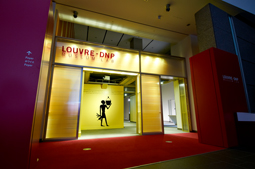 |
|
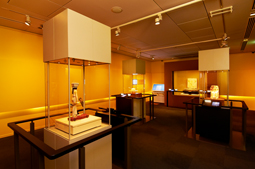 |
| The LDML entrance from the ground-floor lobby of the DNP-Gotanda Building, at night. |
|
The Presentation Room, which houses the original works of art from the Louvre. Seen here is the current Offerings for Eternity exhibition, which showcases several funerary offerings from ancient Egypt. |
Now in its sixth year, an ongoing collaboration between the world's most celebrated museum and a Japanese printing company is yielding some breakthroughs in exhibition display technology.
An up-front disclaimer: the company in question is Dai Nippon Printing (DNP), sponsor of this website. The museum is the Louvre. How these two far-flung entities came to collaborate is a story in itself, but to get to the point: there is some remarkable stuff going on in the field of multimedia exhibition displays, and much of it can be viewed here in Tokyo.
The public face of the Louvre-DNP Museum Lab (LDML) is, essentially, a very small museum. The exhibits occupy a single gallery off the ground-floor lobby of the DNP Building in Gotanda, and generally consist of a single work, or set of works, of art held by the Louvre. The shows are renewed approximately every six months; there have been eight to date, displaying works that range from paintings by Titian, Gericault, and van Hoogstraten to Sevres porcelain, early Islamic ceramics, and ancient Greek sculpture. The current exhibition, Offerings for Eternity in Ancient Egypt: A Question of Survival, centers around the stela of Sakherty, a limestone tablet created as a funerary offering during Egypt's Middle Kingdom, ca. 1970-1900 BCE. It can be viewed until March 4.
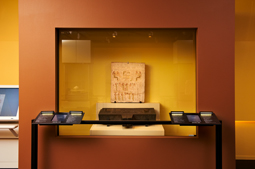 |
|
 |
| The stela of Sakherty (Middle Kingdom, ca. 1970-1900 BCE) and the offering table of Horiraa (Late Period, ca. 664-525 BCE), with iPad-type descriptive displays on either side. |
|
A large digital display to the left of the stela of Sakherty invites visitors to touch-select items of clothing worn by figures engraved on the stone tablet for more detailed explanations of their significance.
|
The small scale of these exhibits makes sense when one realizes that they are an experiment in progress, and that their main purpose is to develop and test new display techniques that employ a mix of cutting-edge digital technologies. Thus a single painting becomes the touchstone for several more roomsful of interactive display tables, sensor-triggered audio and visual installations, and "touchy-feely" corners where visitors can handle replicas of the original art. A small theater shows films providing historical context on the works displayed. The overall emphasis is on the effort of DNP and the Louvre to place the technologies collectively known as Augmented Reality (AR) at the service of museums. The innovations on view at LDML have evolved over the course of the project, and currently include many of the features now familiar to smartphone users -- selecting, rotating, enlarging, dragging and scrolling, all with the touch of a finger or two -- but on a far vaster scale.
What makes this exciting to the visitor is not only the size of the screen displays, but the degree of interactivity they offer. Instead of an iPad, we get to play on table-size panels to manipulate maps of excavation sites, historical timelines, and close-up views of the artwork. The map tables in particular are a stunning blend of printed graphics and movable display elements projected from above. Touch-panel circuitry embedded in the table surface responds to the viewer's fingers, allowing one to riffle through a selection of items to display or enlarge.
At the
Offerings for Eternity exhibition, a large panel next to the stela of Sakherty offers a detailed look at its iconography. In the theater, a film that can be viewed in English, French, or Japanese relates the myth of the god Osiris, to whom the stela is dedicated. In the foyer outside the gallery, a huge map table encourages visitors to explore Abydos, the sacred city of Osiris. Another table uses close-ups of works from the Louvre's collection to highlight the graphic conventions of ancient Egyptian art. In another corner, a replica of the offering table of Horiraa, one of the exhibit items, invites the visitor to reenact a funeral offering ritual, replete with incantations and virtual incense smoke.
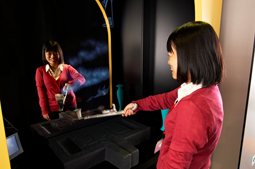 |
|
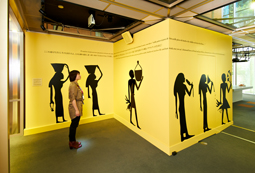 |
| The Augmented Reality system responds to the position of the user manipulating a device -- here a replica of an Egyptian priest's incense burner -- to waft virtual "smoke" across the mirror. |
|
Standing in this spot triggers a sensor that plays a recording of a prayer chanted in what is purported to be ancient Egyptian. |
The Louvre has incorporated some of these innovations in its own permanent collections, and they have caught the attention of other institutions as well. Currently, elements of DNP-developed technology are in use at several museums in Japan, and the lab has received inquiries from museums, corporate showrooms, and factories in Europe, North America, the Mideast, Africa, and Southeast Asia.
This novel collaboration evolved from a relationship that goes back at least to 1998, when DNP helped the Louvre develop Cyber Louvre, a multimedia space where visitors to the museum could search its collection online. Other joint projects followed, including construction of the Louvre's Japanese-language website, culminating in a request from the museum for DNP's assistance in developing multimedia displays that would enhance the experience of visitors from diverse linguistic and cultural backgrounds. Without this history of cooperation, it seems unlikely the Louvre would be so willing to ship several of its treasures halfway around the world every six months.
As befits a project that began in cyberspace, the LDML website provides a wealth of detail -- in three languages -- about the project, its exhibitions, and the technology that goes into them. All of this is edifying enough. But for a real sense of what the Louvre-DNP collaboration may hold in store for museum-goers of the future, I recommend a visit to the Lab itself. Non-Japanese visitors in particular will appreciate the Lab's thorough translations of all the display text into English and French.
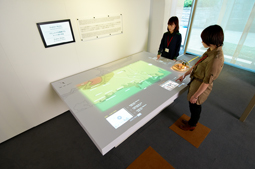 |
|
 |
| Sensors in this tabletop map of the sacred city of Abydos respond to touch, enabling users to interact with a new "projection mapping" technology that combines printed and projected images. |
|
Like giant iPads, viewing tables allow visitors to flip through a wealth of images illustrating the graphic conventions of ancient Egyptian art.
All photos © DNP |